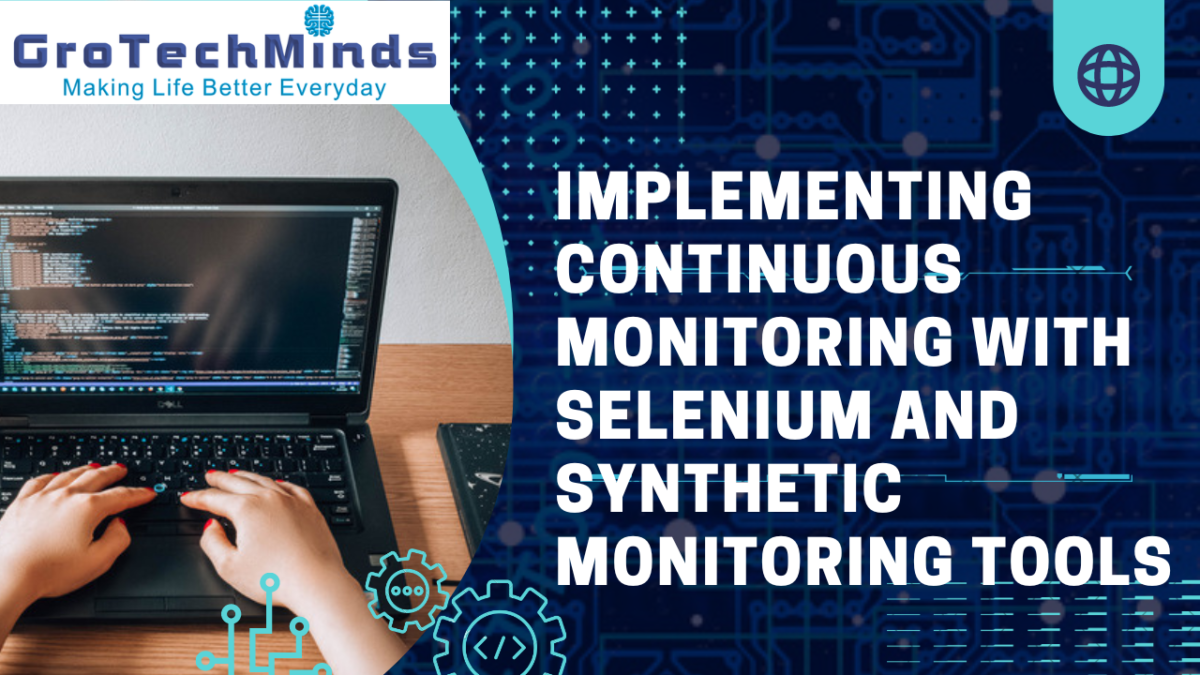It is critical to guarantee the performance and dependability of web apps in the current fast-paced digital environment. Consumers anticipate flawless experiences, therefore any downtime or performance problems could cost you money and harm the reputation of your company. It is crucial to put continual monitoring procedures in place in order to meet these needs. This post will cover the use of Selenium and synthetic monitoring technologies, their significance, and best practices for incorporating them into your development and operational workflows.
Understanding Continuous Monitoring
The process of routinely evaluating and tracking the functionality, availability, and performance of software applications at every stage of development and beyond is known as continuous monitoring. Continuous monitoring offers real-time insights into the behavior of applications in production environments, in contrast to traditional testing methodologies, which often take place at predetermined milestones.
There are many advantages to ongoing observation. Through proactive issue detection, teams can resolve problems before they affect users, which enhances user retention and satisfaction in general. Continuous monitoring also helps teams see patterns in performance over time, which makes it possible to make better decisions about optimizing and scaling infrastructure.
A Brief Overview of Selenium
One popular open-source program for automating web browsers is called Selenium. It makes it possible for programmers and quality assurance specialists to create scripts that mimic user behaviors within online applications, like selecting buttons, completing forms, and navigating between pages.
Selenium’s automated regression testing capability is one of its main features. Teams may make sure that new code changes don’t produce unforeseen side effects or regressions in current functionality by automating repetitive test cases. This speeds up the testing process and increases test coverage overall, boosting confidence in the stability of the application.
Making Use of Synthetic Monitoring Instruments
Although Selenium is great at testing specific web application components, synthetic monitoring technologies simulate user interactions from outside the application, giving a more comprehensive view. These tools may simulate user experiences across numerous pages and transactions, and they usually function from geographically dispersed sites.
When evaluating the overall performance of web applications, including elements like error handling, transaction success rates, and page load times, synthetic monitoring is especially helpful. Teams can swiftly detect performance bottlenecks and availability concerns by continuously monitoring these indicators, which enables prompt response and resolution.
Best Techniques for Execution
It takes careful planning and execution to incorporate Selenium and synthetic monitoring technologies into your continuous monitoring strategy. Consider the following best practices:
Establish Monitoring Objectives: Clearly state your objectives and the key performance indicators (KPIs) you wish to keep an eye on. Metrics like response times, error rates, and customer satisfaction ratings may be included in this.
Automate Testing Workflows: Regression and smoke testing are two common testing procedures that may be automated with Selenium. This gives QA teams more time to work on more intricate testing scenarios.
Diversify your test scenarios: by creating a thorough set that addresses a variety of user interactions and edge circumstances. This lessens the possibility of missing important issues and helps to guarantee comprehensive test coverage.
Monitor from Several Locations: Make use of artificial monitoring tools to evaluate the performance of your application from a variety of geographic locations and network configurations. This gives you information on how users interact with your app across various geographic locations.
Provide alerting systems: To inform teams of any departures from anticipated performance benchmarks, provide alerting systems. This makes proactive incident management possible and guarantees prompt issue resolution.
Iterate Constantly: Examine and improve your monitoring plan on a regular basis in light of the information obtained from automation testing in Selenium and observation. Iterative improvement and optimization are made possible by this method.
Scaling Monitoring Efforts
Monitoring activities must be scaled as firms develop and their application portfolios diversify. Fortunately, your infrastructure and user base can grow using Selenium automation testing and synthetic monitoring technologies. The following tactics will help you scale your monitoring activities successfully:
Code for Infrastructure (IaC): To automate the provisioning and configuration of monitoring infrastructure, adopt the principles of Infrastructure as Code. Infrastructure resources can be managed with the use of programs like Terraform and Ansible, which provide consistency and scalability between environments.
Distributed Testing: To spread the load over several computers and settings, use a distributed testing strategy. For example, Selenium Grid enables you to run tests concurrently on several browsers and devices, which accelerates test execution and boosts overall efficiency.
Orchestration and Containerization: To make the deployment and maintenance of testing environments easier, make use of container orchestration systems like Kubernetes and containerization technologies like Docker. Testing environments that are containerized may be dynamically spun up and down, allowing for quick scalability and resource optimization.
Cloud-Based Solutions: To relieve the strain of managing infrastructure resources, think about utilizing cloud-based monitoring services like AWS CloudWatch and Google Cloud Monitoring. With the scalable and dependable monitoring features these platforms provide, you can concentrate on developing and refining your applications.
In summary
In today’s digital world, continuous monitoring using Automation testing with Selenium and synthetic monitoring technologies is crucial to preserving the dependability and performance of web applications. Teams may prevent problems before they affect users by Automation testing processes, varying test scenarios, and keeping an eye on things from several angles. Through adherence to industry best practices and the adoption of a continuous improvement mindset, companies can guarantee that their applications provide the greatest possible user experience to customers across the globe.
